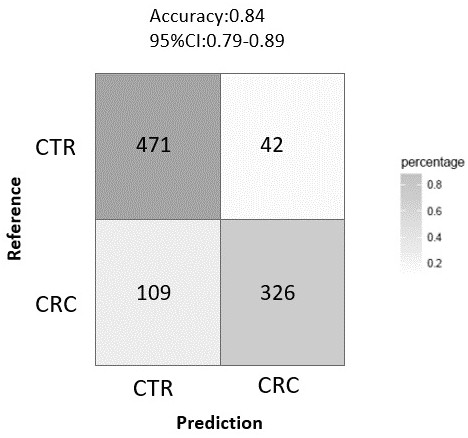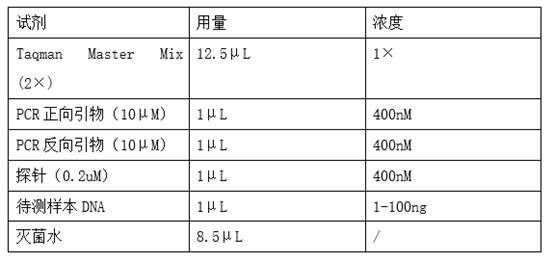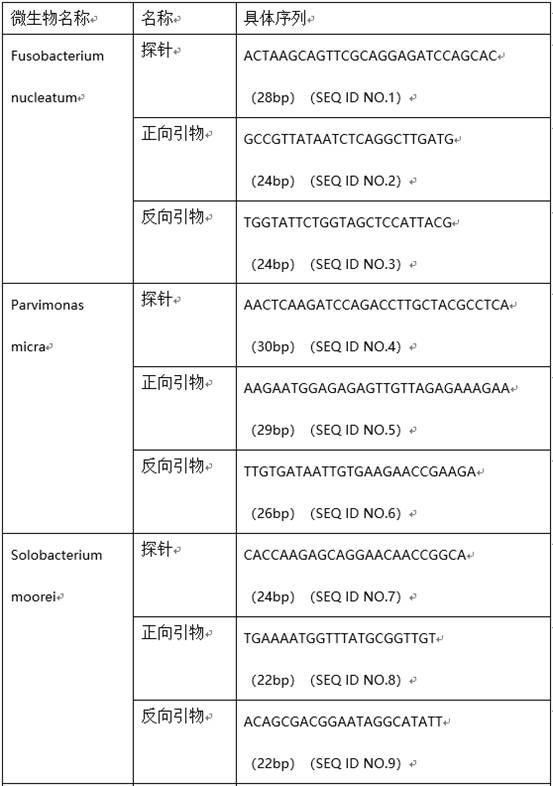Microbial markers for predicting risk of colorectal cancer and application thereof
A colorectal cancer and marker technology, applied in the field of microorganisms, can solve the problems of unfavorable widespread promotion and application, difficulty in data acquisition, increased cost, and high detection cost, and achieve increased patient compliance, good application prospects and practical significance, and sensitivity. high effect
- Summary
- Abstract
- Description
- Claims
- Application Information
AI Technical Summary
Problems solved by technology
Method used
Image
Examples
Embodiment 1
[0054] Embodiment 1, the extraction of DNA sample
[0055] (1) Collect fresh stool samples from the subjects, freeze them immediately, and put them on ice before the experiment;
[0056] (2) Weigh 200 mg of fixed feces into 2 mL centrifuge tubes, add 800 μL of fecal DNA extraction buffer, shake and mix well for 5 min, and centrifuge at 1800 g for 1 min;
[0057] (3) Take 50 μL of the suspension into a 1.5 mL centrifuge tube, add 800 μL of lysate, vortex and mix, lyse at 70°C for 5 min, centrifuge for 5 min, and transfer the supernatant to a clean 1.5 mL centrifuge tube;
[0058] (4) Add 20 μL of well-mixed magnetic beads, vortex for 20 seconds, let stand at room temperature for 4 minutes, place on a magnetic rack, let stand for 20 seconds, and absorb the supernatant;
[0059] (5) Add 500 μL of washing solution Ⅰ, vortex for 20 seconds, mix the magnetic beads, place them on a magnetic rack, let them stand for 20 seconds, and discard the supernatant;
[0060] (6) Add 750 μL of...
Embodiment 2
[0063] Example 2, Quantitative Detection of Microbial Markers
[0064] The quantitative detection of microbial markers adopts the Taqman qPCR method, and the probes and primers used are shown in Table 1:
[0065] Table 1. Probes and primers for microbial markers and internal controls
[0066]
[0067]
[0068] The specific steps of this embodiment are described below taking the TaqMan Master Mix kit product of Suzhou Xinhai Biotechnology Co., Ltd. as an example:
[0069] (1) Prepare the PCR reaction solution according to the qPCR reaction system shown in Table 2;
[0070] Table 2. qPCR reaction system
[0071]
[0072] (2) After the PCR reaction solution is prepared, mix it upside down and centrifuge it, dispense it into a 96-well PCR reaction plate, centrifuge it at 2000g for 2 minutes, seal it and place it in a PCR machine for reaction;
[0073] (3) Use the two-step PCR reaction method to carry out qPCR reaction, and set the program as shown in Table 3;
[0074]...
Embodiment 3
[0077] Example 3, the training of colorectal cancer risk assessment calculation model
[0078] The establishment of the colorectal cancer risk assessment calculation model uses the random forest algorithm to train the abundance information of the above three microbial markers and their grouping information in the collected samples of 513 healthy individuals and 435 colorectal cancer patients and internal data Test, and finally select the optimal model from multiple training models as the follow-up colorectal cancer risk calculation model, the specific steps are as follows:
[0079] Step 1) Collect 513 fresh stool samples from healthy individuals and 435 fresh stool samples from colorectal cancer patients;
[0080] Step 2) extracting and purifying DNA fragments from the stool sample of the individual described in step 1);
[0081] Step 3) Use the TaqMan probe method for qPCR real-time quantification, and detect step 2) the gene content of the target gene fragment of the microbia...
PUM
 Login to View More
Login to View More Abstract
Description
Claims
Application Information
 Login to View More
Login to View More - R&D
- Intellectual Property
- Life Sciences
- Materials
- Tech Scout
- Unparalleled Data Quality
- Higher Quality Content
- 60% Fewer Hallucinations
Browse by: Latest US Patents, China's latest patents, Technical Efficacy Thesaurus, Application Domain, Technology Topic, Popular Technical Reports.
© 2025 PatSnap. All rights reserved.Legal|Privacy policy|Modern Slavery Act Transparency Statement|Sitemap|About US| Contact US: help@patsnap.com



